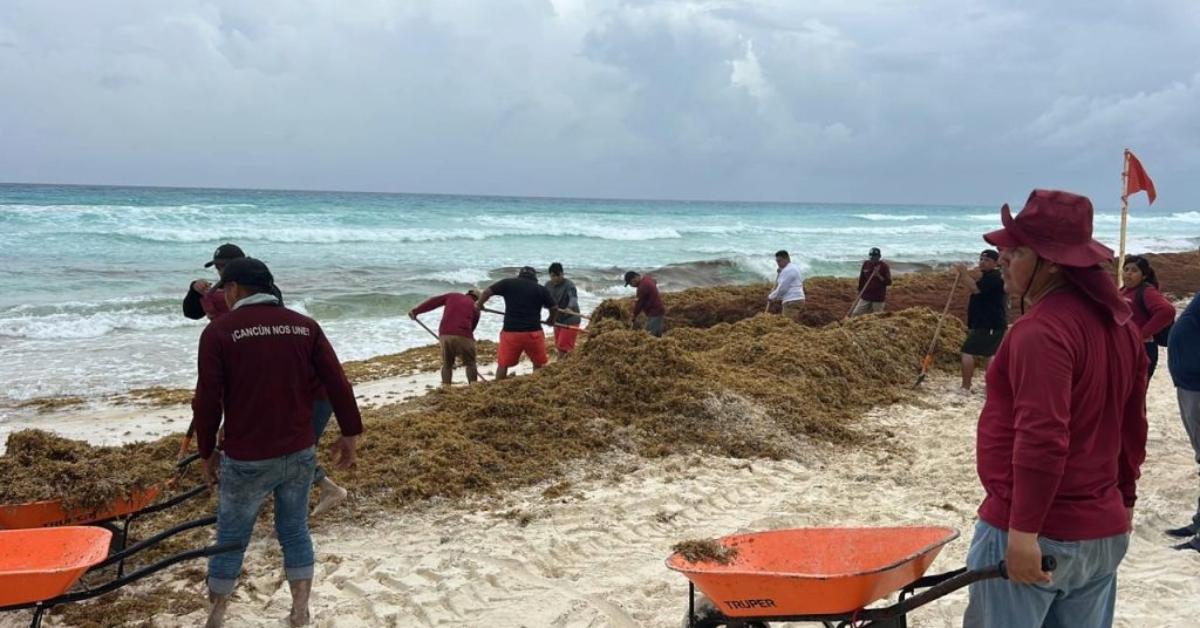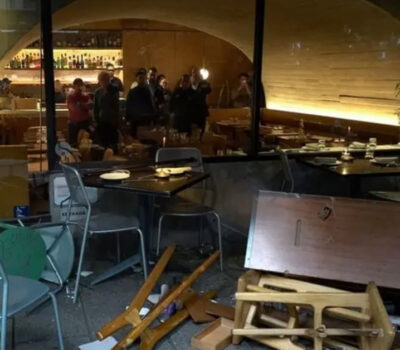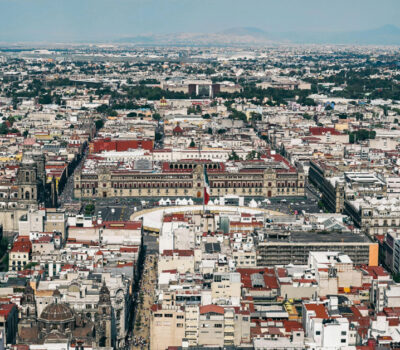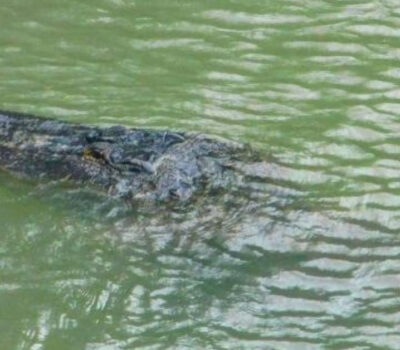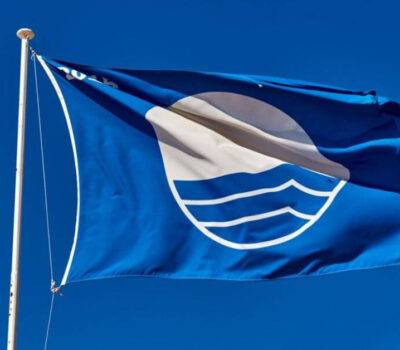Sargassum in Quintana Roo has reached moderate to excessive levels on 76 beaches—including Cancun—as cleanup crews race to protect tourism and coastal ecosystems.
A recent survey from the Quintana Roo Sargassum Monitoring Network and the Sargassum Citizen Observatory shows 76 out of 100 beaches on the state’s Caribbean coast now face moderate to excessive seaweed influx. The surge spans from the hotel zone in Cancun down through Riviera Maya and as far as Tulum, prompting daily cleanup efforts by authorities and private operators.
According to Sunday’s report, 17 beaches registered moderate sargassum arrivals, nine showed abundant levels, and a striking 50 beaches hit the red “excessive” threshold on the Observatory’s traffic-light scale. Cancun’s main coastline remains among the hardest hit, with several shorelines reporting more than a cubic meter of seaweed per linear meter of beach.
“Local teams work before dawn and into the evening to clear sargassum,” said María López, coordinator for the Citizen Observatory. “Our crews use tractors, hand rakes and floating barriers to keep the beach open for visitors. But with this volume, it’s a race against the tide.”
The affected area covers popular destinations across the state: from Punta Cancún and Playa Chac Mool in the north, through Puerto Morelos and the Cozumel ferry zone, to Playa del Carmen and the archaeological beaches near Tulum. In many spots, thick mats of brown algae wash up daily, threatening hotel-zone operations and small businesses that rely on sun-and-sand tourism.
Environmental scientists warn that the current bloom results from a mix of factors. Warmer Caribbean waters fueled by climate change can boost sargassum growth. Nutrient runoff from rivers and agricultural lands farther south may also feed the algae, while shifting currents concentrate blooms along coastal reefs.
Dr. Carlos Ruiz of the National Marine Institute explained, “Moderate levels can benefit local ecosystems by providing habitat for fish. But excessive accumulations block sunlight, alter water chemistry and can harm sea life when decomposing.” He noted that trapped sargassum can lower oxygen levels in nearshore waters, stressing coral reefs and seagrass beds.
Tourism officials remain optimistic. “We know how to handle this,” said Jorge Martínez, head of the Quintana Roo Tourism Board. “Our hotels and beach clubs have protocols in place. We share real-time data with government agencies so they can deploy cleanup crews where they’re needed most.”
Still, some small operators struggle to keep pace. “Last week we cleared the sand by hand,” recounted beach club owner Ana Gómez. “Today I had to pause service twice because the tide brought in new piles.”
State officials stress that public cooperation helps. Observers encourage beachgoers to report dense sargassum via a dedicated hotline and to avoid dragging heavy mats back into shallow water. Each report lets crews target hotspots before they grow unmanageable.
As the summer season proceeds, authorities and scientists will continue weekly assessments. The goal: keep Quintana Roo’s white-sand beaches clear, protect marine ecosystems, and safeguard the region’s vital tourism economy.
1. Overall Beach Conditions
- No Sargassum: 5 beaches
- Very Low Amounts: 19 beaches
- Moderate Arrival: 17 beaches
- Abundant (> high): 9 beaches
- Excessive (red-level): 50 beaches
Local authorities and private teams continue daily cleanup operations to keep coasts clear and safe for visitors.
2. Beaches with the Least Sargassum
Cancún Area
- Cancún (main beaches)
- Playa del Niño
- Puerto Juárez
- Puerta del Mar
- Puerto Cancún
- Playa Las Perlas
- Playa Langosta
- Playa Tortugas
- Playa Gaviota Azul “Fórum”
- Playa Caracol
- Playa Delfines
- Playa San Miguel
- Punta Nizuc
Isla Mujeres & Nearby
- Playa Norte
- Playa Mía
- Playa Centro
- Playa Lancheros
- Punta Sur
- Isla Contoy (no landing)
- Isla Blanca
- Costa Mujeres
- Playa Mujeres
- Punta Sam
- El Palmar
- Cabo Catoche (no landing)
Puerto Morelos
- Puerto Morelos Centro
- Puerto Morelos Norte
Lázaro Cárdenas & Holbox Region
- Chiquilá (no landing)
- Holbox Ferry (no landing)
- Punta Mosquito (no landing)
- Punta Cocos
- Holbox Centro
Cozumel
- Playa Las Uvas
- Playa Chankanaab
- Playa San Francisco
- Playa Mía
- Playa Palancar
- Playa El Cielo
- Punta Sur
- Isla de la Pasión
- Playa Punta Norte
- Playa Las Rocas
- Playa San Juan
- Cozumel Muelle
Playa del Carmen
- Playa Mamitas
Tulum
- No significant sargassum recorded
3. Beaches with the Most Sargassum (Orange/Red Levels)
Cancún to Riviera Cancún
- Punta Cancún (orange)
- Playa Chac Mool (orange)
- Playa Marlin (orange)
- Playa Ballenas (orange)
- Playa Coral
- Riviera Cancún (Hotel Moon Palace, Royalton Riviera)
Puerto Morelos
- Bahía Petempich
- Punta Caracol
- Punta Brava
- Playa El Dorado
Cozumel
- Punta Molas
- Playa Xhanan
- Playa El Castillo
- Playa Mezcalitos
- Playa Chumul
- Playa Chen Río
- Mirador San Martín
- Playa Bonita
- Playa Encantada
- Playa El Mirador
- Punta Morena
- Punta Celarain
Playa del Carmen & Surroundings
- Playa El Secreto
- Playa Valentín
- Playa Vidanta
- Playa Paraíso (orange)
- Punta Maroma (orange)
- Punta Bete
- Playa Xcalacoco
- Punta Esmeralda
- Playa Colosio
- Playa Shangri-La (orange)
- Playa Constituyentes
- Playa El Recodo
- Playacar Ferry
- Playacar Zona Hotelera Fase 1 & 2
- Paamul
- Puerto Aventuras
- Barceló Maya
- Xpu-Ha
Tulum Area
- Kantenah
- Akumal Media Luna
- Akumal
- Bahía Príncipe
- Xcacel-Xcacelito
- Bahía Solimán
- Tankah
- Zona Arqueológica de Tulum (Sur & Norte)
- Punta Piedra
- Zona Hotelera de Tulum Sur
- Arco Maya
Note: “Orange” indicates high arrival; “red” indicates excessive macroalgae (traffic-light system). Cleaning crews remain active every morning and evening to minimize impacts on tourism and local ecosystems.
Sargassum in Quintana Roo has reached moderate to excessive levels on 76 beaches—including Cancun—as cleanup crews race to protect tourism . . .

